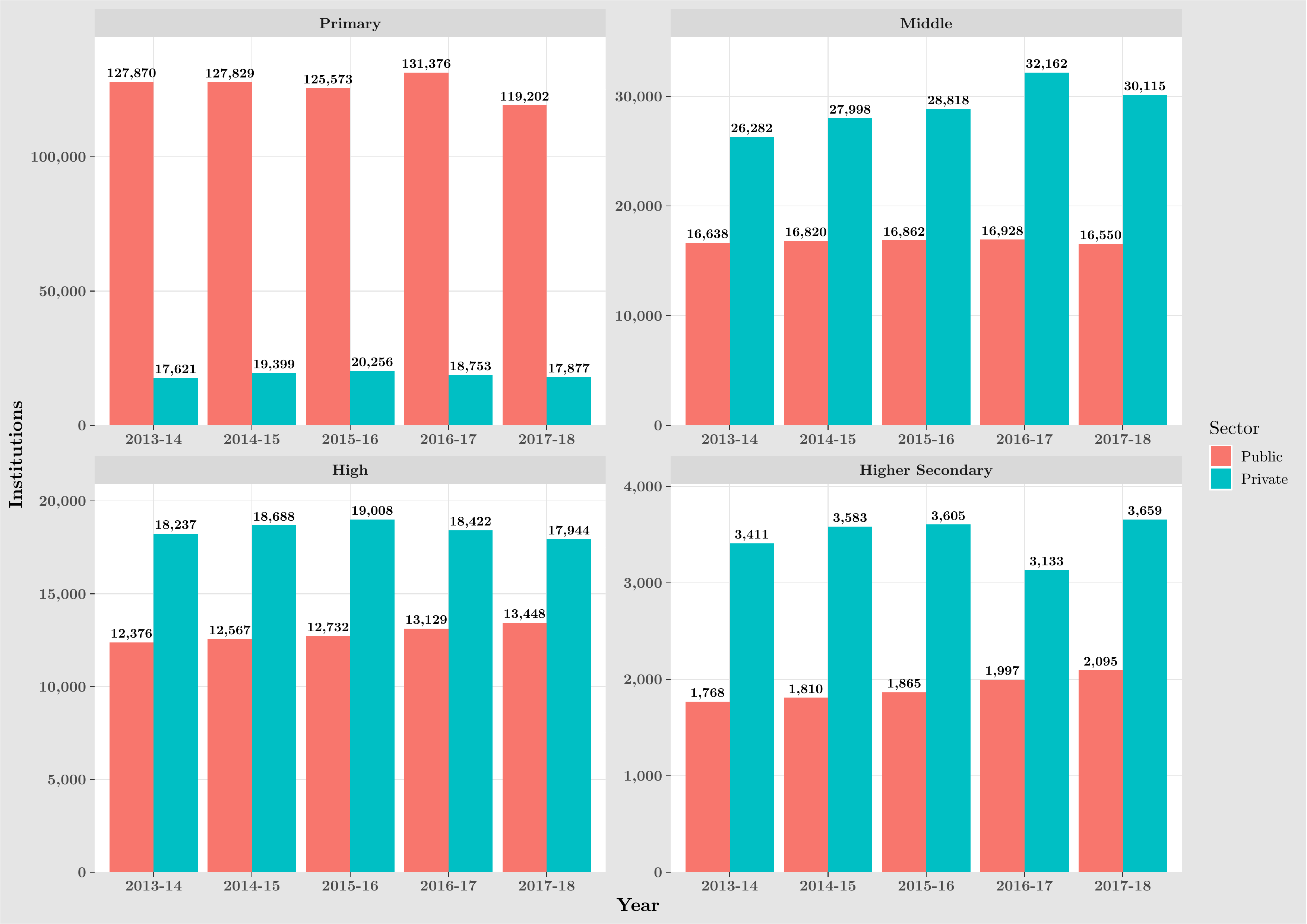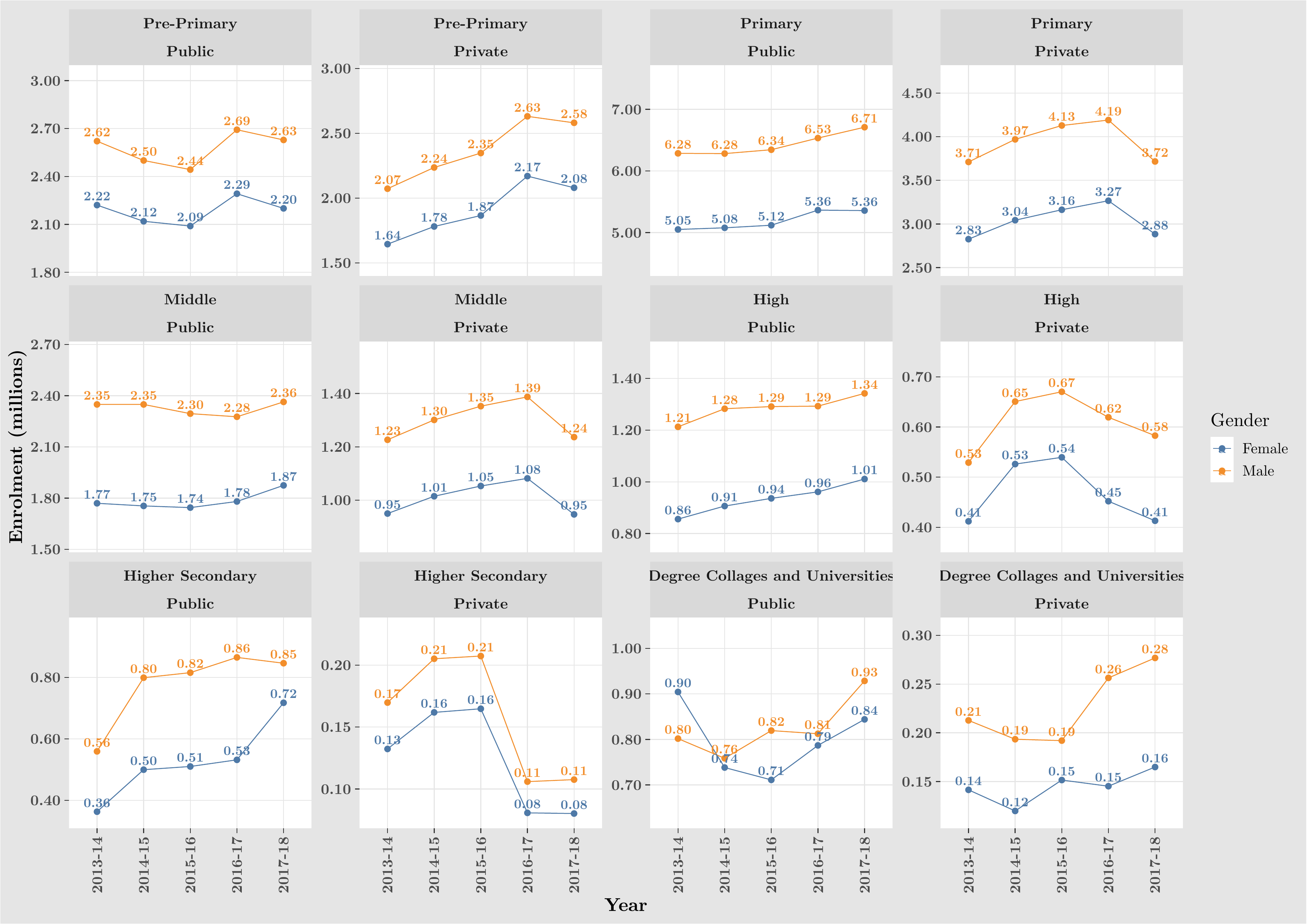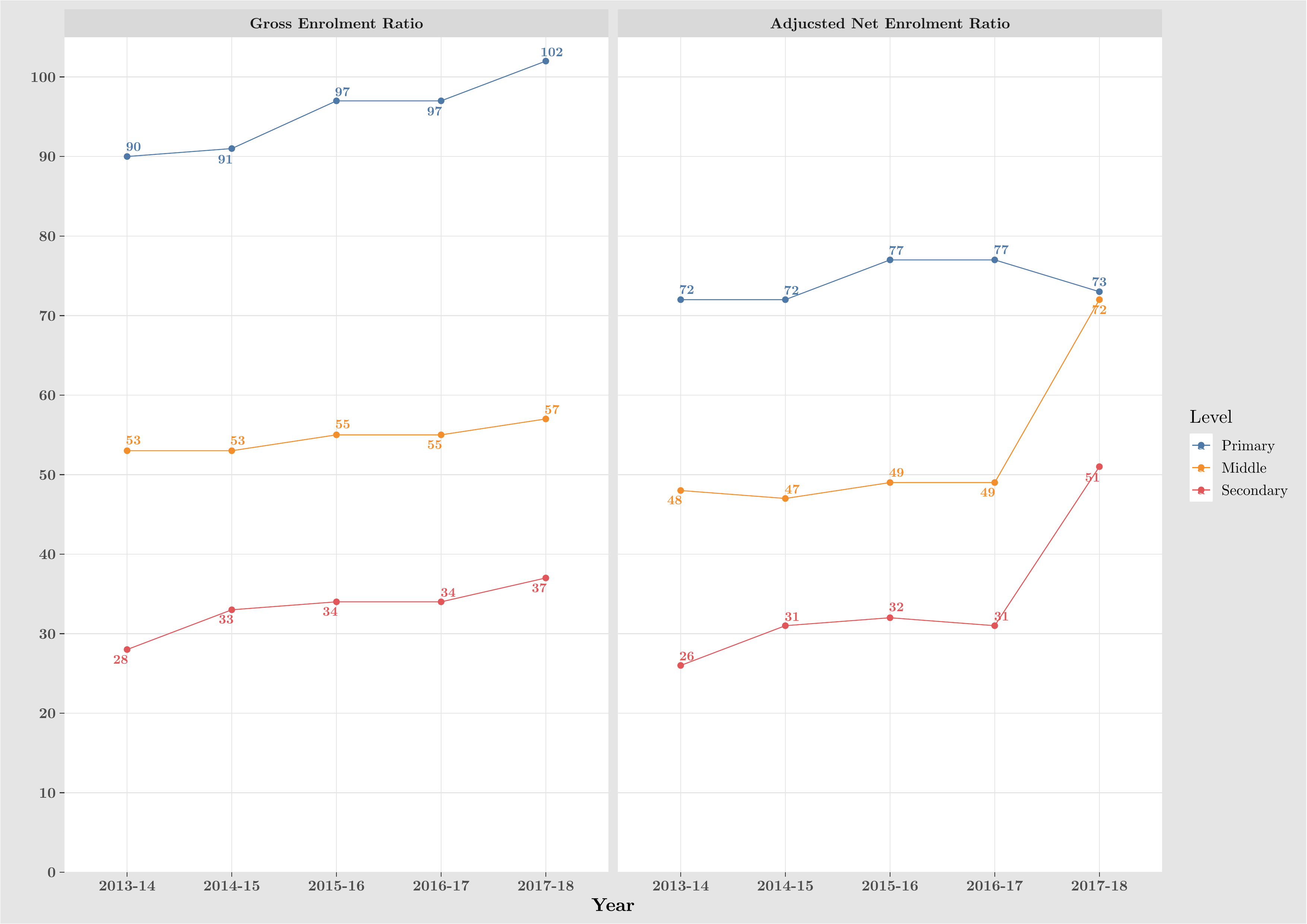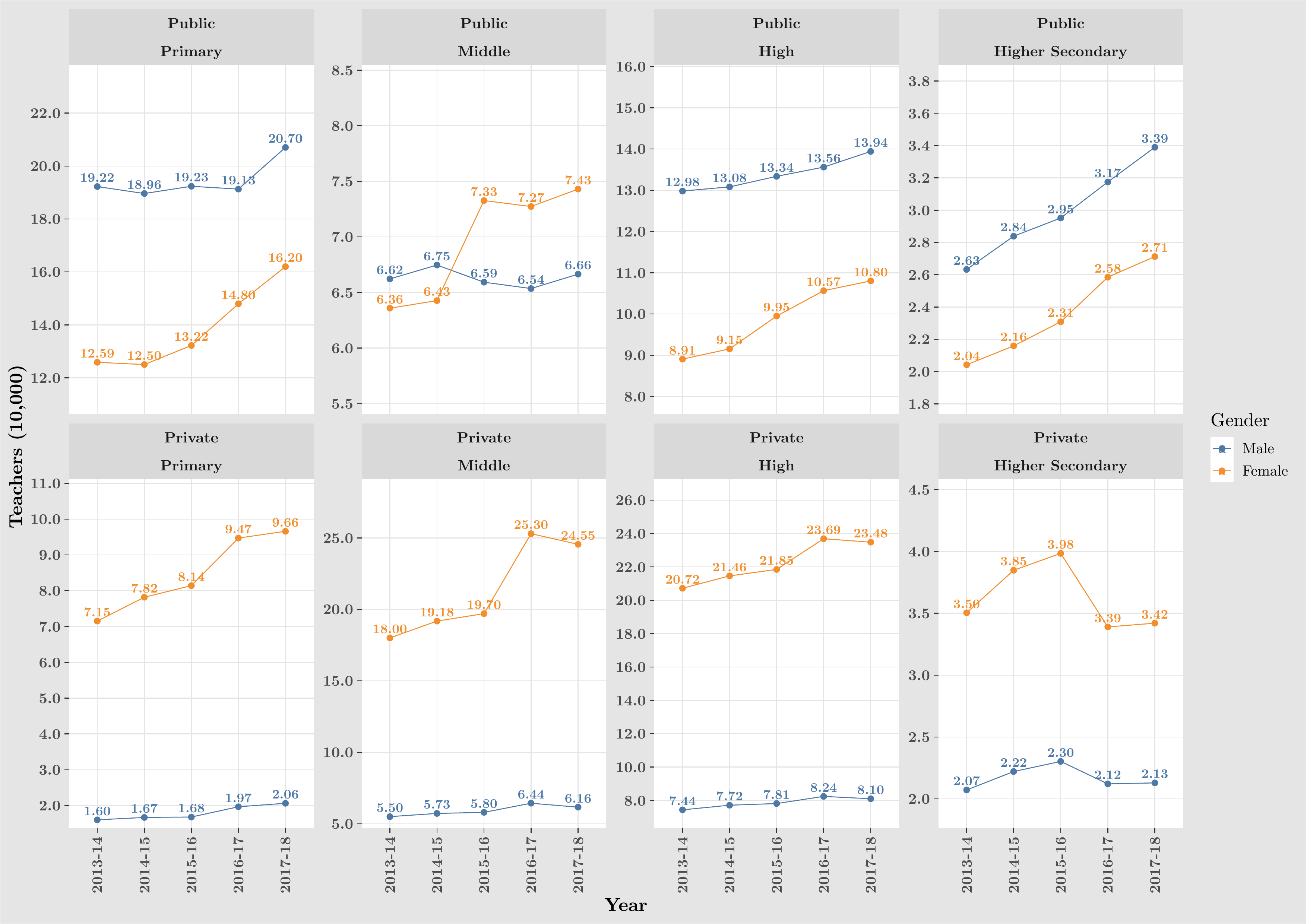3 Trends in Education Statistics
This chapter focuses on the analysis of data collected through Annual School Census (ASC) over the last five years. The intent is to discern any pattern in the values collected during this time period for the purpose of future planning and decision making.
The indicators used in this comparative analysis cover the census years 2013-14 to 2017-18, a five year time series to study trends in education. The basic components of education, including institutions, enrolment and teachers at National level are highlighted in this chapter.
Since ASC focuses on public sector institutions of primary to higher secondary levels. Data on private sector was also compiled and a comparison of trend over the last five years is discussed/presented below.
3.1 Institutions
Educational institution (school) is one of the major components of any education system. This part of the chapter focuses on the comparison of public/private sector educational institutions of primary to higher secondary levels.
At primary level a seven percent decline in the number of public school occurred. This decline was even more (9%) over the last year. Possible reason for this decline may be:
Up-gradation of primary schools to higher levels
Closing of non-functional schools, as per rationalization policy of the government
Merger of schools, due to non-availability of teachers or lack of enrolment.
In the private sector there was a marginal increase of about 256 schools over the last five year period. The number of schools at primary level in the private sector rose to 20,256 in 2015-16 which dropped to 17,877 in 2017-18, showing a 13 percent decrease over the last three years.

Figure 3.1: Five Years Comparison of number of Schools by Education level from 2013-14 to 2017-18
At the middle level the number of public schools remain almost constant. However, there is a 14 percent increase in the number of middle schools in the private sector.
The number of high schools both in public and private sectors remains stagnant with the number of public high schools fluctuating around 13,000 and private high schools around 18,000.
A very significant increase in the number of higher secondary schools in the public sector was observed. In 2013-14 there were 1,768 higher secondary schools in the public sector which rose to 2,095 in 2017-18 with an increase of about 18 percent over the last five years. In the private sector the corresponding increase over the same period was about seven percent. The major reason for these increases was due to the up-gradation at different levels (Fig. 3.1).
3.2 Enrolment
At the pre-primary stage of education there were 9.49 million enrolments out of which 4.83 million students were enrolled in public sector schools while the remaining 51 percent were in the private sector schools. The number remained almost similar over the last five years. For private schools the enrolment during 2013-14 was 3.716 million which increased to 4.660 million in 2017-18 showing an increase of 25 percent which is a matter of concern for the government (Table 7.1).
At the pre-primary stage of education, an increase of about eight and seven percent has been observed against 2015-16 in enrolment of males and females respectively. At primary stage of education an increase of 4.4 percent was recorded over the last five years in public and private institutions enrolment.

Figure 3.2: Five Years Comparison of Enrolment by Education level, Sector and Gender from 2013-14 to 2017-18
At middle stage of education, a decrease of one percent in the enrolment of males and an increase of two percent in the enrolment of females has been observed during 2017-18.
In 2013-14, there were 1.12 million males and 0.76 million females enrolled at High-Stage of education all over the country. With the passage of five years, in 2017-18, the high stage of education has enrolled 1.92 million males and 1.42 million females. This shows an increase of 11.3 and 17.7 percent in males and females enrolment, respectively, over the time. An eleven percent increase in the enrolment is observed over the last five years.
A very significant increase of 17 percent in the enrolment at the higher secondary stage has been observed all over the country. In School Census year 2013-14, 1.17 million students were enrolled at higher secondary education stage all over the country. Five years later, in 2017-18, the public sector of education in the country enrolled 1.37 million students in higher secondary education. Five year comparison of enrolment by public/private as well as male/female is depicted in Fig. 3.2.
There are similar patterns in the pre-primary, middle and high school enrolments for both public and private schools for male and female enrolments. However, there is a decline from 2016-17 to 2017-18 for private schools at primary, middle and high school levels. There are more fluctuations in the enrolment of public and private institutions by gender in the higher secondary level and at higher education level. In HEC institutions enrolment of both genders increased from 2015-16 to 2017-18 which is an indication of students now joining private sector institutions of higher learning.
Five years trend from 2013-14 to 2017-18 of GER at national level show a 12, 4 and 9 percent increase at primary, middle and secondary levels respectively. In the ANER a very small one percent increase over the five years at primary level was observed. A sharp increase at middle and secondary level of ANER values showed 23 and 20 percent over the last year is observed due to change in the methodology of adjustment which is now based on a random sample survey for age specific information conducted by NEMIS (Fig. 3.3).

Figure 3.3: Five Years Comparison of Gross and Adjusted Net Enrolment Ratios by Education level from 2013-14 to 2017-18
3.3 Teachers
Currently, the overall public sector education system is being served by 0.944 million teachers while five years earlier the system had the services of 0.830 million teachers, indicating that over this time period, 13 percent more teachers were added to the system. Much higher increase in the number of teachers is noticed in the private sector where the number of teachers increased from 0.764 million in 2013-14 to 1.130 million in 2017-18 showing a 48 percent growth in the last five years. This is mainly due to the establishment of educational foundations hiring new teachers in Punjab, KP, and also by an increase of about one hundred thousand teachers in Deeni Madaris.
There is sizeable increase over the last five years in the induction of new teachers in the formal education system with the highest increase of 34 percent at the primary level in the private sector. The corresponding increase in the public sector was 16 percent. At the middle school level also there was more increase in the private sector (31%) as compared to public sector (9%). A decrease in the number of teachers in the private sector was observed at the inter college level.

Figure 3.4: Five Years Comparison of number of Teachers by Education level, Sector and Gender from 2013-14 to 2017-18
At middle schools although slight decrease of 0.9 percent has been observed in male teachers and 1.4 percent in female teachers, as compared to 2015-16, but a five percent overall increase is evident over the last five years. In high schools, the number of teachers has also increased over the last five years. The number of high school teachers has risen to 238,633 from 210,114 since the census year 2013-14, i.e., an increase of 14 percent during the last five years. Higher Secondary Schools have seen an increase of 27 percent in the teachers during last five years with figure reaching upto 59,655 from 47,079 (Table 8.2). The Fig. 3.4 shows trends in number of teachers employed by public and private sector with respect to gender for different stages of school education. It is obvious that at all levels there are more male teachers in the public sector except in middle stage for the last three years when females out numbered male teachers. The trend over the five year period is also increasing. In the private sector female teachers are many more as compared to male teachers at all stages.